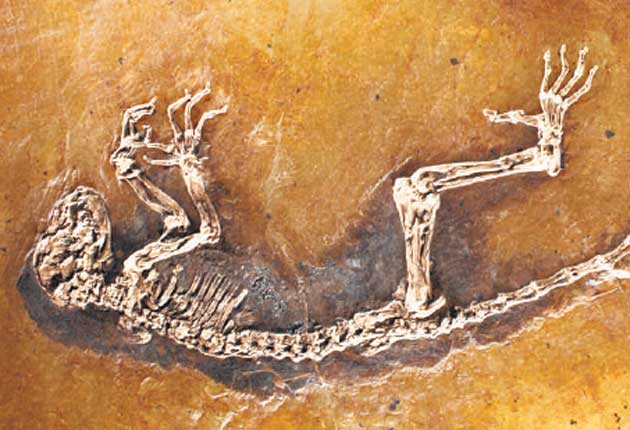Review of the Year 2009: Discoveries
We saw Darwin in a whole new light

Climate change, stem cells and evolution were the three big science themes of 2009, which happened to be the 200th anniversary of the birth of Charles Darwin and the 150th anniversary of his seminal book, On the Origin of Species by Means of Natural Selection. It was the year when Darwin's remarkable insight into the evolution of life on earth was celebrated around the world.
But perhaps the most intriguing story of the year was the incredible tale of the shrinking sheep on the Scottish island of Hirta in the St Kilda archipelago, a study that managed to merge the two topics of evolution and climate change. For nearly a quarter of a century the wild Soay sheep on this windswept isle have been getting smaller when Darwinian natural selection should in theory have been making them larger.
The sheep, which fend for themselves, should have been growing bigger because larger sheep are more likely to survive the harsh St Kilda winters. Size is largely determined by genes so, given that larger sheep were more likely to survive, big-sheep genes should be at a premium in the Darwinian struggle for survival.
However, scientists found that milder winters and, more importantly, earlier springs were giving smaller lambs the opportunity of surviving through their first year. Previously, larger lambs that put on weight fastest during their first summer were the most likely to survive until the following spring – but not so in a warmer climate. This has meant the Soay sheep have shrunk by about 5 per cent over a quarter of a century – quite a dramatic change – as a result of climate change and earlier springs.
The observations provided a neat example of evolutionary change occurring within a wild population of animals living in a changing environment.
Another animal to hit the headlines in a big way in 2009 was Ida, the 47-million-year-old fossil of a primitive, tree-dwelling mammal named after the six-year-old daughter of Oslo University scientist Jorn Hurum, who purchased the fossil from a private collector. Ida was heavily billed as the "missing link" between the line of primates leading to apes, and man, and the rest of the animal kingdom.
The promotion was orchestrated by the well-oiled public relations machine of a film company that made a documentary on the fossil's discovery and analysis. In addition to a film and a book, the publicity also included acres of news coverage and even a dedication on the Google search page.
The fossil of Ida, formally named Darwinius masillae in honour of Darwin, showed her to be a juvenile creature about 3ft long from head to tail, which is an impressive appendage about as long as her body. Some of her well-preserved features, including opposable thumbs, demonstrated that she was our ultimate ancestor – or so the publicity stated.
However, subsequent studies later in the year cast doubt on whether Ida deserved this poll position on the line of descent leading to humans. Many scientists took the view that, although she was an interesting specimen, this remarkable fossil was of a creature belonging to a species that was an evolutionary side-branch of the primate lineage. Ida was not our ancestor, and not the much-hyped "missing link", they concluded.
Hype of course is never far away from scientific achievements. At one time it was thought that Britain would be the global nerve centre for generating stem cells from "hybrid" embryos created by fusing human cells with animal eggs that had their nuclei removed. The Government even changed the law to make sure that hybrid embryos would be legal.
However, although stem cells continued to dominate the pages of the scientific literature in 2009, it emerged that none of the three scientific teams with licences to work on hybrid embryos had received the necessary funding. Two of the three academics named on the three licences had gone to work in other countries and the third had left academia to work in industry.
Despite this setback, stem cell research continued in other areas. Chinese scientists showed that it may be possible to delay the menopause by transferring female stem cells that develop into mature eggs. Meanwhile, British scientists announced that they hope to use stem cells to make industrial quantities of synthetic blood.
In terms of straight observations, 2009 was marked by the discovery – definitive this time – of water on the Moon. Nasa scientists analysing the data sent from the lunar crater observation and sensing satellite, which was deliberately crashed into the Cabeus crater at the lunar South Pole, announced that they had discovered "buckets" of water, a find that could be useful for a permanently manned lunar base.
Meanwhile, another team of Nasa scientists said that they had discovered vast plumes of methane on Mars. Further studies ruled out a volcanic source of the gas, suggesting only one other possibility – underground lifeforms.
But the real scientific story of 2009 was the continuing research here on Earth into climate change. Further studies supported the view that global warming and climate change are proceeding at a faster rate than many had predicted.
In 2009, the Royal Society published its long-awaited report on geoengineering, the artificial manipulation of climate to counter the effects of man-made emissions of carbon dioxide. The report warned, ominously, that if there is failure at the political level to curb carbon emissions, there may come a time when the world has no other option than to try the far more drastic and risky measures of geoengineering.
Join our commenting forum
Join thought-provoking conversations, follow other Independent readers and see their replies
Comments